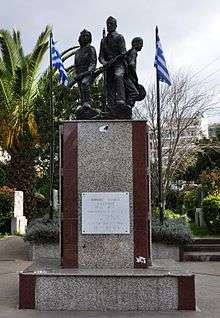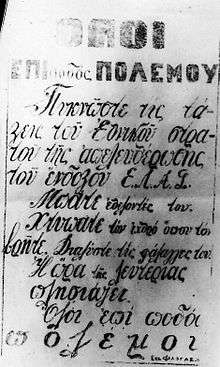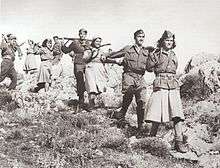Greek People's Liberation Army
| Greek People's Liberation Army Ελληνικός Λαϊκός Απελευθερωτικός Στρατός | |
|---|---|
| Participant in the Greek Resistance and the Dekemvriana | |
 Monument of ELAS, Galatsi. | |
| Active | 1942–1945 |
| Leaders |
Aris Velouchiotis (Chief Captain) Major General Stefanos Sarafis (Chief military officer) Political commissar Andreas Tzimas (Chief political supervisor) |
| Size | 50,000 - max.100,000 |
| Part of | National Liberation Front |
| Allies | Soviet Union, SNOF, Albanian Partisans, Bulgarian Partisans, Yugoslav Partisans, SOE |
| Opponents | German Army, Royal Italian Army, Kingdom of Bulgaria, Collaborationist government, Security Battalions, EDES/EOEA, EKKA/5/42 Evzone Regiment, YVE/PAO, Organization X, Cities Police, Greek Gendarmerie, British Army (1944) |
The Greek People's Liberation Army (Greek: Ελληνικός Λαϊκός Απελευθερωτικός Στρατός, translit. Ellinikós Laïkós Apeleftherotikós Stratós), commonly known by its acronym ELAS (ΕΛΑΣ), and often mistakenly called the National People's Liberation Army (Εθνικός Λαϊκός Απελευθερωτικός Στρατός, Ethnikós Laïkós Apeleftherotikós Stratós), was the military arm of the left-wing National Liberation Front (EAM) during the period of the Greek Resistance until February 1945, when, following the Dekemvriana clashes and the Varkiza Agreement, it was disarmed and disbanded.
Birth of ELAS
After Nazi Germany attacked the Soviet Union with the initiation of Operation Barbarossa (June 22, 1941 — with most of Greece having fallen under Axis occupation since April and the Battle of Crete having ended on June 1 — the Greek Communist Party (KKE) called for national resistance. The KKE together with minor parties of the Left formed a political structure called National Liberation Front. They were joined by other, center-left or non-politicised Greek resistance militants.
On February 16, 1942, EAM gave permission to a communist veteran, called Athanasios (Thanasis) Klaras (later known as Aris Velouchiotis) to examine the possibilities of a victorious armed resistance movement. It was the birth of the Greek People's Liberation Army (ELAS). ELAS initiated actions against the German and Italian forces of occupation in Greece on 7 June 1942. Aris Velouchiotis with a small group of 10–15 guerrillas entered the village of Domnista in Evrytania and proclaimed in front of the surprised villagers that they had set off to "start the war against the forces of Axis and their local collaborators". Initially, Velouchiotis collected also the traditional local mountain living bandits, like Karalivanos, in order to create a small group of experts in guerilla fighting.
Consolidation of strength
Gorgopotamos

On a night in September 1942, a small group of British SOE officers parachuted into Greece near Mt. Giona. This group, led by Brigadier Eddie Myers, had been tasked to blow up one of three bridges (Gorgopotamos, Papadia or Asopos) of the country's main railway line, and to get the two main, but competing, guerrilla groups of ELAS and EDES to cooperate.
After much deliberation, the Gorgopotamos bridge was chosen due to the difficulty of making repairs to the structure. But, for the mission to succeed, it was important to meet the guerrillas. Dimos Karalivanos, an ELAS guerrilla, was the first guerrilla the British found. At the end of October a second group of British officers were parachuted into the Greek mountains. Their leaders were Themis Marinos and Colonel Christopher Woodhouse. Their mission was to locate the guerrillas of EDES and their leader Napoleon Zervas, who were friendlier to the British Headquarters of the Middle-East than ELAS, and co-operate with them. The resulting mission was a challenge for the two guerrilla groups, EDES and ELAS. Finally, they agreed to collaborate. The British did not favour the participation of ELAS, because it was a pro-communist group, but the forces of ELAS were larger and better organised, and without their participation, the mission was likely to fail. So, in a rare and unique event, ELAS and EDES-EOEA joined forces.
On November 14, the 12 British saboteurs, the forces of ELAS (150 men) and those of EDES (60-65 men) met in the village Viniani in Evrytania and the operation started. Ten days later, the forces were at Gorgopotamos. On the night of November 25, at 23:00, the guerrillas started the attack against the Italian garrison. The Italians were startled, and after little resistance, they were defeated. After the defeat of the Italians, the saboteurs set the explosives. ELAS forces also had placed ambushes on the routes towards the bridge, to block the approach of Italian reinforcements. The explosion occurred at 03:00. Afterwards, the guerrillas' forces returned to Viniani, to celebrate the success of the mission.
The destruction of the Gorgopotamos bridge was, along with the Norwegian heavy water sabotage in Rjukan, one of the two biggest guerrilla acts in occupied Europe. The blowing up of the bridge disrupted the German transportation of ammunition via Greece to Rommel's forces for several weeks, taking place at a time where the German forces in North Africa, retreating after the defeat of El Alamein, were in absolute necessity of provisions.
From 1942 to 1943: the turning point
| Part of subjects related to the |
| Communist Party of Greece |
|---|
 |
|
Media
|
|
Communism Portal Politics of Greece Communist parties in Greece |


The blowing up of Gorgopotamos bridge favored ELAS.[1] Soon, lots of the inhabitants of the villages of Central Greece became members of ELAS. Furthermore, people sympathised with the ELAS guerrillas because they weren't helped by the British in contrast with EDES. When 25 guerrillas deserted from ELAS, Aris Velouchiotis went to Epirus to threaten Napoleon Zervas not to come in touch with them. Later, the 25 deserters were arrested and executed in the village of Sperhiada. The winter of 1942, ELAS groups were formed in other Greek regions, like Thessaly and Macedonia. In Central Greece, Aris Velouchiotis succeeded to form a powerful semi-conventional army which could attack German and Italian forces. Aris became a legendary figure who imposed an iron discipline in ELAS. At the same time, some members of ELAS (Periklis, Tasos Leuterias, Diamantis, Nikiforos, Thiseas, Dimos Karalivanos, and Belis) have been distinguished during the battles. Aris Velouchiotis formed a group of 30–35 men, called "Mavroskoufides" (the "black caps"), who were his personal guards. During the winter of 1942–1943, new units of ELAS were composed in many regions of Greece. Some areas in the mountains of Central Greece passed from the control of Axis forces to that of ELAS.
The leadership of ELAS followed a triadic form, from its top down to platoon level: the captain (kapetánios), elected by the men and the overall leader of the unit, the military specialist (stratiotikós), usually a regular Army officer, responsible for tactical planning and training, and the political leader (politikós), usually a KKE member, as EAM's representative. At its top, the General Headquarters of ELAS, these positions were filled by Aris Velouchiotis, Stefanos Sarafis and Andreas Tzimas (nom-de-guerre: Vasilis Samariniotis).
Two events of great importance took place in this period. KKE, after passing great difficulties, succeeded in reorganizing its groups destroyed by Metaxas. Lots of members were recruited and with the help of ELAS, which became the largest partisan army in Greece, EAM became the largest mass political organization in Greek history, claiming over 1.5 million members, enlisted in organizations that covered every neighborhood in every village. The second great event was the foundation of the United Panhellenic Organization of Youth (EPON) (Greek: Ενιαία Πανελλαδική Οργάνωση Νέων). In 1943, a small naval auxiliary navy, the Greek People's Liberation Navy (ELAN) was also founded.
Two years after its foundation, ELAS' military strength had grown from the small group of fighters in Domnitsa to a force of some 50,000 partisans (estimates of the British government) or even as many as 85,000, according to EAM sources; EAM itself, and its associated organizations, had grown to a membership of anywhere from 500,000–750,000 (according to Anthony Eden) up to two million, in a country of 7.5 million inhabitants.[2] ELAS was thus one of the largest resistance groups formed in Europe, similar to the French Maquis, the Italian Resistance and the Yugoslavian Partisans, but smaller than the Polish resistance.
The "Mountain Government"
On 10 March 1944 the EAM-ELAS, now in control of most of the country, established the Political Committee of National Liberation (PEEA), widely known as the "Mountain Government" (Greek: Κυβέρνηση του βουνού, translit. Kyvérnisi tou vounoú), in effect a third Greek government to rival the collaboration one in Athens and the government-in-exile in Cairo. Its aims, according to its founding Act, were, "to intensify the struggle against the conquerors (...) for full national liberation, for the consolidation of the independence and integrity of our country (...) and for the annihilation of domestic fascism and armed traitor formations."
PEEA was elected in liberated territories and in occupied ones by 2,000,000 Greek citizens. It was historically the first time that women could vote. PEEA ministers covered a wide political spectrum from left to center.
First Civil War
ELAS became the strongest of all resistance armed organizations, controlling by 1944 military three-fifths of the country (mainly the mountains) having in its ranks more than 800 military officers of the former National Army. ELAS engaged in battles against other resistance groups, besides the para-military forces of the collaborationist government. ELAS initially began to attack the National Republican Greek League (EDES) on accusations of collaboration with the Germans. ELAS attacked also the Panhellenic Liberation Organization (PAO), another resistance organization, concentrated in Northern Greece, in the area of Macedonia with accusations of collaboration. The armed power of the two major organizations was not comparable as EDES had approx. 12,000 guerrillas, while ELAS' power was much stronger. Small battles were taking place in Epirus where EDES had its main force. This situation led to triangular battles among ELAS, EDES and the Germans. Given the support of the British and the Greek Cairo Government for EDES, these conflicts precipitated a civil war. In October 1943 ELAS launched major attacks against EDES and the guerrilla group of Tsaous Anton in Northern Greece, precipitating a civil war across many parts of Greece which continued until February 1944, when the British agents in Greece negotiated a ceasefire (the Plaka agreement); ELAS broke the agreement by attacking the 5/42 Evzone Regiment, murdering the EKKA resistance group leader, Dimitrios Psarros, in as yet unclear and hotly debated circumstances and executing all the captives.
List of important battles
1942
- The battle of Ryka (40 Italians killed)
- The battle of Mikro Chorio (70 Italians killed)
- November 1942 – The battle of Gorgopotamos
1943
- March 1943 – The battle of Fardykambos (together with PAO, 95 Italians killed)
- June 1943 – The destruction of the Kournovo Tunnel (c.100 Italians killed)
- July 1943 – The battle of Myrtia
- The battle of Sarantaporo (99 Germans killed)
- The battle of Porta (many Italians killed)
- September 1943 – The battle of Arachova
1944
List of important ELAS members





This list contains the names of the most well-known ELAS leaders or simple members, with their nom de guerre in parentheses:
- Athanasios Klaras (Aris Velouchiotis), chief captain of ELAS
- Colonel Stefanos Sarafis, chief military expert of ELAS
- Andreas Tzimas (Vasilis Samariniotis), chief political commissioner of ELAS
- Georgios Siantos
- Major General Neokosmos Grigoriadis (Lambros), Chairman of ELAS Central Committee
- Lieutenant General Ptolemaios Sarigiannis, Chief of Staff of ELAS Central Committee
- Colonel Evripidis Bakirtzis, commander of ELAS' Macedonian theatre
- Captain Theodoros Makridis (Ektoras), one of ELAS chief staff officers
- Alexandros Rosios (Ypsilantis)
- Markos Vafiadis, Macedonian theatre
- Nikos Beloyannis
- Charilaos Florakis (Kapetan Jiotis)
- Iannis Xenakis
- Giannis Aggeletos (Leon Tzavelas), blackberet
- Giannis Economou (Giannoutsos), blackberet
- Panos Tzavelas
- Evangelos Yannopoulos (Varjianis)
- Father Dimitrios Holevas (Papa-Holevas, Papaflessas)
- Father Germanos Dimakos (Papa-Anypomonos)
- Alberto Errera
- Fotis Mastrokostas (Thanos), blackberet
- Kostas Kavretzis (Kostoulas Agrafiotis), blackberet
- Babis Klaras, brother of Aris Velouchiotis
- Giannis Madonis (Ektoras), blackberet
- Giannis Nikolopoulos (Leon), blackberet
- Dimitrios Dimitriou (Nikiforos)
- Giorgos Houliaras (Periklis)
- Pantelis Laskas (Pelopidas), blackberet
- Epaminontas Chairopoulos (Karaiskakis), blackberet
- Ioannis Alexandrou (Diamantis)
- Lambros Koumbouras (Achilleas)
- Spyros Tsiligiannis (Lefteris Chrysiotis), blackberet
- Kostas Athanasiou (Doulas), blackberet
- Sarantos Kapourelakos, serving directly under Velouchiotis' command.
- Spyros Bekios (Lambros)
- Dimitrios Tassos (Boukouvalas)
- Thomas Pallas (Kozakas)
- Nikos Xinos (Smolikas)
- Vangelis Papadakis (Tassos Lefterias)
- Vasilis Priovolos (Ermis)
- Gerasimos Avgeropoulos
- Andreas Zacharopoulos (Andreas from Patras)
- Ioannis Hatzipanagiotou (Thomas)
- Christos Margaritis (Armatolos)
- Georgios Zarogiannis (Kavallaris)
- Vasilis Ganatsios (Cheimarros)
- Panagiotis G. Tesseris, Secretary of the ELAS Guerrilla Warfare Training Committee (Laconia Region)[3]
Αftermath
In autumn 1944, after the liberation, ELAS was the dominant force in the country and had captured all the major Greek cities, except Athens (after an agreement in Caserta with the Greek government in exile).
After the Dekemvriana events, ELAS was disarmed, though later some of its fighters (mostly KKE members) joined the Democratic Army during the civil war.
Hymn
The hymn of ELAS was written in March 1944 by Sofia Mavroeidi-Papadaki and music by Nikos Tsakonas.
| Greek Με το τουφέκι μου στον ώμο, σε πόλεις κάμπους και χωριά, της Λευτεριάς ανοίγω δρόμο; της στρώνω βάγια και περνά. Εμπρός Ε.Λ.Α.Σ. για την Ελλάδα, το Δίκιο και τη Λευτεριά; σ’ ακροβουνό και σε κοιλάδα, πέτα! πολέμα με καρδιά. Ένα τραγούδι είν’ η πνοή σου, καθώς στη ράχη ροβολάς, και αντιλαλούν απ’ τη φωνή σου καρδιές και κάμποι: ΕΛΑΣ! ΕΛΑΣ! Παντού η Πατρίδα μ’ έχει στείλει, φρουρό μαζί κι εκδικητή, κι απ’ την ορμή μου θ’ ανατείλει καινούργια λεύτερη ζωή. Με χίλια ονόματα, μία χάρη, ακρίτας ειτ’ αρματολός, αντάρτης, κλέφτης, παλικάρι; πάντα ειν’ ο ίδιος ο λαός. |
Translation March E.L.A.S. for Hellas, the Right and Freedom; in mountainpeaks and in valleys, fly! fight with your heart. A song is your breath, while in the ridge you walk, and from your voice resound hearts and plains: ELAS! ELAS! Everywhere the Homeland has sent me, guard and a revenger too, and from my impetus rises a new free life. With thousand names one charm, akritas or armatolos, rebel, klepht, lad; it's always the People itself. |
See also
References
- ↑ Mazower, M. Inside Hitler's Greece: The Experience of Occupation, 1941-1944 (2001); Yale Nota Bene Books; p. 140.
- ↑ Stavrianos 1952, p. 44.
- ↑ "Original Official ELAS Military Release Document". E.L.A.S 1945.
Sources
- Eudes, Dominique (1973). The Kapetanios: Partisans and Civil War in Greece, 1943-1949. Translated by John Howe. New York and London: Monthly Review Press. ISBN 978-0-85345-275-1.
- Grigoriadis, Solon (1982). Συνοπτική Ιστορία της Εθνικής Αντίστασης, 1941-1944 [Concise History of the National Resistance, 1941-1944] (in Greek). Athens: Kapopoulos.
- Hellenic Army History Directorate (1998). Αρχεία Εθνικής Αντίστασης, 1941-1944 [National Resistance Archives, 1941-1944]. Athens: Hellenic Army History Directorate. ISBN 978-9607897060.
- Mazower, Mark (1993). Inside Hitler's Greece: The Experience of Occupation, 1941–44. New Haven and London: Yale University Press. ISBN 0-300-06552-3.
- Sarafis, Stefanos (1951). Greek Resistance Army: The Story of ELAS. London: Birch Books. OCLC 993128877.
- Stavrianos, L. S. (1952). "The Greek National Liberation Front (EAM): A Study in Resistance Organization and Administration". The Journal of Modern History. 24 (1): 42–55. JSTOR 1871980.
- Vafeiadis, Markos (1985a). Απομνημονεύματα, Β' Τόμος (1940-1944) [Memoirs, Volume II (1940-1944)] (in Greek). Athens: A. A. Livanis.
- Vafeiadis, Markos (1985b). Απομνημονεύματα, Γ' Τόμος (1944-1946) [Memoirs, Volume III (1944-1946)] (in Greek). Athens: A. A. Livanis.